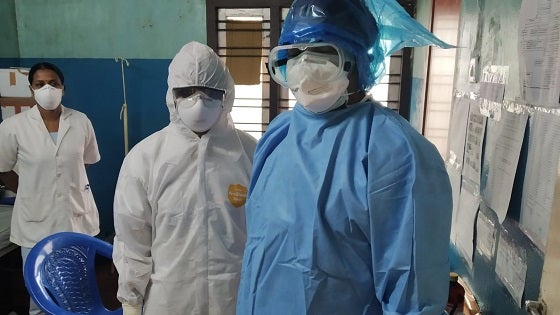Summary
India, which appeared relatively unscathed by the Coronavirus, has reported a spike in cases over the last few days. As Indian authorities put in place extensive screening mechanisms and detection measures, they are concerns over the adequacy of detection facilities and trained human resources to battle the virus.
Till about a week ago, India was one of the brighter spots in the global struggle against the Coronavirus (COVID-19). As more and more cases surfaced in China, Japan, South Korea, Italy, Iran, Germany and France, India looked safe and almost untouched by the COVID-19 outbreak. Apart from three cases identified in Kerala with travel history to Wuhan in early February 2020, no other cases were reported from India.
The situation appears to be changing from a week ago. A sudden spike has seen the number of identified cases in India rise to around 40 with more results awaited.
The increase in the number of infected people has now raised concerns over whether COVID-19 has begun spreading deep in India. It has also begun raising questions over how India managed to ward off the virus till now and whether its systems and institutions are prepared to tackle the outbreak.
Indian authorities acted fast in responding to COVID-19. Right from the end of January 2020, Indian airports began screening passengers from China and Southeast Asian countries like Singapore and Thailand, which were among the early ones to detect the virus. Some state governments, such as Kerala, directed home quarantine for all travellers returning from COVID-19-affected countries.
From late February 2020 onward, COVID-19 spread its wings fast and wide, descending on Europe, the Middle East and greater Asia-Pacific. South Korea, Japan, Italy and Iran experienced rapid surges in cases almost at the same time. Indian screening arrangements, though, were still primarily focused on China, and could not, like most other countries, react immediately to the pan-continental orientation of the virus.
Many of those infected in India have travel histories to Italy and Europe, including a group of Italian tourists currently quarantined in India. India is now screening all international passengers at its airports. The step might have come a little late in the day though as the virus appears to have found its way into India.
Globally, India is still way down in the list of countries with people affected by COVID-19. Nonetheless, it is a country where the epidemic can travel exceptionally fast, thereby making it, in some respects, particularly vulnerable.
India’s major challenges in fighting COVID-19 include the sheer scale of precautions it has to undertake. During the first couple of months of the year, Indian airports handled more than 80,000 incoming international passengers daily. Screening so many passengers is exceptionally difficult. The manual thermal screening of passengers is not only time-consuming, but also requires the deployment of additional trained manpower. Furthermore, Indian authorities are asking for self-declaration from incoming passengers on their recent travel histories and local co-ordinates in India. The requirements, while necessary, have increased paperwork for overburdened immigration desks.
The time required to carry out the screening and paperwork – weeks, probably months, given that the end of COVID-19 is nowhere in sight – would impose a serious strain on human resources deployed at the borders. The ironical flipside is that the volume of incoming passengers might reduce with Indian airlines slashing flights to and from affected countries following advisories on avoiding non-essential travel. However, essential travel, for unavoidable personal and business reasons, will continue, and that itself might not be insignificant. Moreover, while airports are under the scanner of press and social media users, seaports and land borders hardly are. The latter are particularly difficult to screen. India’s porous land borders with Bangladesh and Nepal are major worries in this regard.
Concerns are arising over how to tackle the epidemic once it finds toehold within India. The fatality rate of COVID-19, till now, is low, compared with other major viruses that have hit India and the world in recent years, such as H1NI, Swine Flu, Ebola and the Severe Acute Respiratory Syndrome. However, deaths from COVID-19 display high vulnerability for those suffering from adverse medical conditions such as cancer, diabetes and respiratory disorders. In a country of more than a billion people, and with a high incidence of various lifestyle and external condition-induced diseases, catching COVID-19 might complicate the medical conditions of many. This is particularly true for rural areas, where knowledge of COVID-19 is low and detection facilities are limited. Indeed, the number of laboratories equipped to test COVID-19 itself in India, around 50 now, is insufficient. Though private healthcare providers are trying to complement the government’s efforts, it would be a while before they become available far and wide. There are also concerns over a lack of sufficient trained physicians and caregivers as well as dwindling supplies of personal protection equipment like face masks and hand sanitisers, making the task look rather daunting.
While cases are spiking in India, the rest of South Asia has reported a very low number of cases till now. If this is due to precaution and awareness, and lesser exposure to virus ‘import’ from travellers, then it is good news. However, if it is due to limited detection facilities, poor awareness and reluctance to disclose numbers so as to not attract adverse attention on national public health systems in a region that does not distinguish itself on healthcare indicators, then there is cause for concern.
. . . . .
Dr Amitendu Palit is a Senior Research Fellow and Research Lead (Trade and Economic Policy) at the Institute of South Asian Studies (ISAS), an autonomous research institute at the National University of Singapore (NUS). He can be contacted at isasap@nus.edu.sg. The author bears full responsibility for the facts cited and opinions expressed in this paper.
-
 More From :
More From :
-
 Tags :
Tags :
-
 Download PDF
Download PDF



